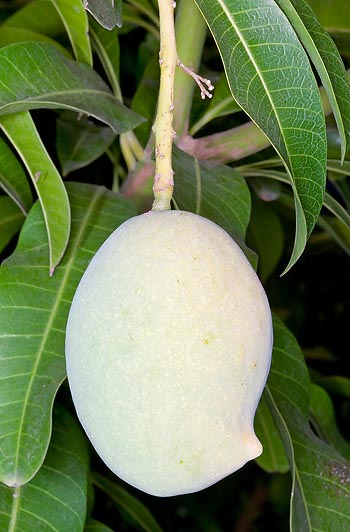Family : Anacardiaceae

Text © Pietro Puccio

English translation by Mario Beltramini

Characteristic profile of the fruit. The tree is 30 m tall © Giuseppe Mazza
The Mangifera zeylanica (Blume) Hook. f. (1876) is native to Sri Lanka, where it grows mainly in the forests along the rivers in the humid climate zones as well in the rather dry ones due to the irregular rains, up to an altitude of 1.000 metres.
The name of the genus comes from the combination of one of the local names of the fruit, “manga” with the Latin verb “fero” = I carry.
The name of the species comes from the Latin “zeylanica” = of Ceylon (Sri Lanka) with reference to its place of origin.
Common names: “atamba”, “etambe” (Sinhalese); “Sri Lankan mango”, “wild mango” (English); “mangueira do Ceilão” (Portuguese).
It is an imposing evergreen tree which may reach the height of 30 metres – the tallest tree, along with Campnosperma zeylanica, in the family of the Anacardiaceae – with a slightly fissured bark of a brown grey colour and brownish orange soft wood.
The leaves are leathery, lanceolate or oblong-ovate, of a glossy dark green colour, up to 20 cm long and with a pointed 7-13 cm apex in the young plants, and rounded apex in the adult ones.
The inflorescences are panicle terminal, with greenish-yellow flowers, the fruits are ovoid, 3-4 cm long, with fibrous pulp, theoretically edible, but not too attractive.
The plant, not much cultivated, is at times utilized as rootstock of the Mangifera indica.
Locally, the wood is utilized for fabricating common usage objects, small boats and as a combustible.
All the parts of the plant have been variously utilized in the traditional medicine and are, nowadays, a possible source of polyphenolic compounds, particularly the mangiferin, extracted from the bark, which has shown interesting properties in the struggle against the cardiac and cancerous diseases.
Synonyms: Buchanania zeylanica Blume (1851).
→ To appreciate the biodiversity within the ANACARDIACEAE family please click here.
